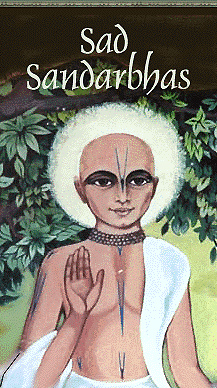
BY: SUN STAFF
Nov 28, CANADA (SUN) —
Tattva Sandarbha
by Srila Jiva Goswami
SECTION TWO
In Kali-yuga, we take shelter of Sri Krishna Caitanya by congregational chanting of the holy names. He is blackish within but golden without and He manifested the opulence of His beautiful bodily limbs to the common people.
Sri Jiva Toshani Commentary
Here Srila Jiva Gosvami explains the meaning of the opening verse. Lord Krishna, whose color is blackish, covered Himself with the golden color of Srimati Radharani to appear as Krishna Caitanya in Kali-yuga. He is the Supreme Personality of Godhead, but His purpose is to show us how to be a devotee. For this reason, it is not readily apparent that He is the Supreme Lord, thus Srimad Bhagavatam describes Him as the "hidden incarnation."
Or the words krishnam and gauram may be taken to mean, not blackish and golden respectively, but that He is Krishna within, though outwardly He appeared as Gaura. Srila Jiva Gosvami also indicates that one can please Lord Krishna Caitanya, by chanting the Hare Krishna maha-mantra.
Darsitangadi-vaibhavam means that Lord Caitanya Mahaprabhu manifested His opulence through His limbs and associates. His body was so beautiful that people surrendered to Him just by seeing Him. He also manifested His supremacy through His associates, such as Nityananda Prabhu and others, who preached the message of chanting the holy name. This phrase can also mean that Lord Caitanya manifested the supremacy of His associates by engaging them in distributing love of Godhead.
By using the plural form "we" in the phrase "we take shelter of Sri Krishna Caitanya ..." Srila Jiva Gosvami includes the readers of Sri Shat-Sandarbha. They, along with him, should take shelter of Lord Caitanya by participating in the sankirtana movement, which is the universal process to please the Supreme Lord and attain deliverance. Sri Jiva also implies that Lord Caitanya's teachings are not limited to a particular sect or nationality.
So far Srila Jiva Gosvami has described his worshipable Deity. Next, he performs Asirvadatmaka Mangalacarana, invocation with pronunciation of glories.
Go to Section Three
Return to Section One
